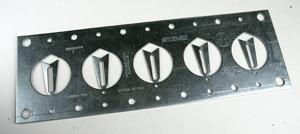- FMA
- The Fabricator
- FABTECH
- Canadian Metalworking
Categories
- Additive Manufacturing
- Aluminum Welding
- Arc Welding
- Assembly and Joining
- Automation and Robotics
- Bending and Forming
- Consumables
- Cutting and Weld Prep
- Electric Vehicles
- En Español
- Finishing
- Hydroforming
- Laser Cutting
- Laser Welding
- Machining
- Manufacturing Software
- Materials Handling
- Metals/Materials
- Oxyfuel Cutting
- Plasma Cutting
- Power Tools
- Punching and Other Holemaking
- Roll Forming
- Safety
- Sawing
- Shearing
- Shop Management
- Testing and Measuring
- Tube and Pipe Fabrication
- Tube and Pipe Production
- Waterjet Cutting
Industry Directory
Webcasts
Podcasts
FAB 40
Advertise
Subscribe
Account Login
Search
Waterjet accelerates stamper's aerospace prototyping
Entire process runs more smoothly
- September 23, 2010
- Article
- Waterjet Cutting

Metal Products Engineering reduced prototyping tooling costs on aerospace components using a waterjet.
Metal Products Engineering, Los Angeles, began business as a Lockheed subcontractor in 1940. The company specializes in contract manufacturing services, including R&D, custom tooling, prototyping, metal stamping, forming, waterjet cutting, and assembly
Since then the company has designed and built an impressive inventory of customized progressive dies in its facility for aerospace applications.
To remain competitive throughout the years, the company supplemented its aerospace business with a diversified customer base of commercial products. The stamper now also serves customers in the military, construction, lighting, plumbing, hardware, medical, and sporting equipment segments.
To serve their customers better, owners Ridge and Paula Luppen sought to reduce the cost of producing tooling as well as increasing productivity in the press department. They investigated and evaluated using a waterjet machine to produce prototype dies.
Waterjet Quickens Prototyping
The stamper bought an OMAX® Corp. MAXIEM 1515 waterjet JetCutting Center to cut the dies for prototypes. With waterjet technology, Metal Products can produce functional prototypes at economical prices, according to the company. This allows its aerospace and other customers to finalize the part design before the progressive die is built, thereby eliminating many costly modifications and delays.
The waterjet allowed the company to keep smaller jobs cost-efficient. They can also respond to short turnarounds or immediate prototype requests.
“The waterjet allows us to serve our aerospace customers better since we can produce small-quantity part runs more cost-effectively than we had been able to do with hard tooling,” said President Ridge Luppen.
It helped that one of the company’s employees was already familiar with waterjet technology and programming.
The aerospace designs often must meet specifications for Underwriter Laboratories (UL) certification. When the company worked on a trapeze bracket design for a Chicago-based company, the waterjet was used to produce a series of prototype parts with different tab designs for the customer and UL to evaluate. Once the design was finalized, the expensive progressive die was built without delays or modifications. This allowed Metal Products Engineering to begin high-volume production immediately after the completion of the die.
Can Use Forming Dies Sooner
“With our company’s standard forming tools, we can use our waterjet for the blanking operation and then move on to the forming equipment more quickly,” Paula Luppen said.
The process improvement has benefited other areas as well, according to the company. Metal Products Engineering often works with inventors. The waterjet technology has allowed the company to produce inexpensive prototypes and short runs in metals, plastics, wood, rubber, glass, and other materials. This has allowed the company to help the inventor move rapidly from the concept stage to a finished product.
“In the past we turned down small-volume jobs because we didn’t have the technology to do the project,” Paula said. “Now that we have the waterjet, we can do the small jobs, which often means we get the larger jobs as well. In short, we are able to serve our customers’ needs better now that we have the MAXIEM.”S
subscribe now

The Fabricator is North America's leading magazine for the metal forming and fabricating industry. The magazine delivers the news, technical articles, and case histories that enable fabricators to do their jobs more efficiently. The Fabricator has served the industry since 1970.
start your free subscription- Stay connected from anywhere

Easily access valuable industry resources now with full access to the digital edition of The Fabricator.

Easily access valuable industry resources now with full access to the digital edition of The Welder.

Easily access valuable industry resources now with full access to the digital edition of The Tube and Pipe Journal.
- Podcasting
- Podcast:
- The Fabricator Podcast
- Published:
- 04/16/2024
- Running Time:
- 63:29
In this episode of The Fabricator Podcast, Caleb Chamberlain, co-founder and CEO of OSH Cut, discusses his company’s...
- Trending Articles
AI, machine learning, and the future of metal fabrication

Employee ownership: The best way to ensure engagement

Steel industry reacts to Nucor’s new weekly published HRC price

Dynamic Metal blossoms with each passing year

Metal fabrication management: A guide for new supervisors

- Industry Events
16th Annual Safety Conference
- April 30 - May 1, 2024
- Elgin,
Pipe and Tube Conference
- May 21 - 22, 2024
- Omaha, NE
World-Class Roll Forming Workshop
- June 5 - 6, 2024
- Louisville, KY
Advanced Laser Application Workshop
- June 25 - 27, 2024
- Novi, MI


























